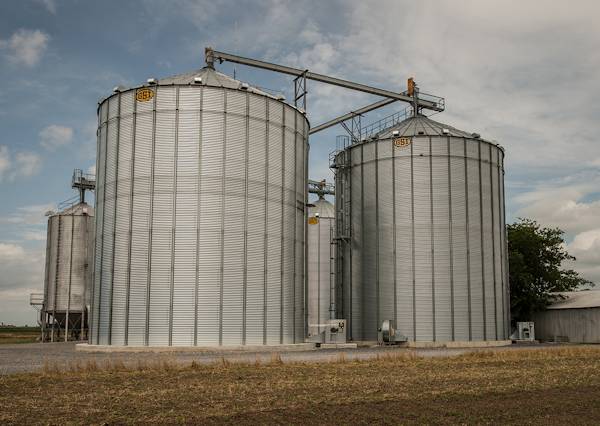September 18, 2015

Greg Trame is an expert on grain handing equipment. As the global product manager for Agco’s storage division, GSI, he knows the markets for grain bins, dryers, grain legs and all the related components that go into storing grain on the farm. We caught up with Trame at the Farm Progress Show and asked how the technology is changing.
What are some demand trends you are seeing in bins?
Grain bins are getting a lot larger. As producers continue to grow in size, they are looking for more on-farm storage.
Last year we came out with a grain bin series with 288,000 bu. storage capacity. We make grain bins that are much larger than that for commercial use that will store up to 1.2 mill bu.
What’s the most popular bin size?
That’s a difficult question because we have farmers who are buying the largest bins we make. Traditionally farmers were always in that 30,000 bu. capacity. But we have famers now installing 500,000 bu. bins and more. But a lot are moving to the 50,000 to 150,000 bu. storage range. That is a nice manageable size for the larger farms.
What are some features buyers are looking for?

Greg Trame, global product manager for Agco GSI’s storage division, says bins as large as 500,000 bu. And 4,000 bu/hr tower dryers are seen on farms. (Photo by Lena Swearingen)
Farmers are looking for features traditionally reserved for our large commercial customers, grain processors and grain trading companies. The difference between the traditional farm customer and the commercial customer are going away because of the amount of grain they are handling. Farms today are bigger than what the small elevators used to be. So farmers are demanding different features in the products that they get.
What are the differences?
Many of them have to do with design. As bins get larger, you are handling more bushels. But the amount of time to handle those extra bushels hasn’t changed. So you need to handle them faster. With faster handling, comes larger grain handling equipment, which means you have to put more load on the roof of the bin. On our new bins for the farm market we have redesigned the roof to handle more load and changed the top of the roof to allow for easier attachments. For example, the tower and the catwalk can be easily integrated for one common solution. We’ve also added stiffeners on the outside of the bin to handle the increased storage capacity. So those are some of the key design components that allow us to get to that larger capacity bin.
Where are grain handing setups headed? What’s the trend?
The general trend is bigger and faster. They want to be able to store their entire corp. Storage is giving them control of their grain marketing decisions. And they are trying to get through harvest as quickly as they can. They have a three to four week window to get harvest done, so all of the grain handling equipment has to be sized to transfer and store that grain within that window.
When did you start seeing the upsizing?
We saw a lot of resizing happen with the last boom in commodity prices, when farmers had bigger budgets to invest in infrastructure. But the interesting thing about grain storage is that at that time, with high commodity prices, there wasn’t a great ROI in grain storage, whereas now, with lower commodity prices, being able to store your crop is the difference between making a profit or not. So grain storage is really important in those low-commodity price situations like we are in now, especially if there is a large crop sitting in field. Being able to store through the harvest season and sell next year can let you capture that basis. It can be 20 to 40 cents/bu. if the market conditions hold like they are now, especially with a large crop.
What trends do you see in grains dryers?
A lot of discussion has been around the efficiency of dryers. As gas prices and electricity prices continue to go up, farmers want the most efficient dryer. And dryers are getting larger as well because as farmers expand the rest of the operation, the dryer is usually the bottleneck in a grain handling setup. So we are seeing a lot of producers continue to upgrade to faster dryers. And when they go faster and upgrade, they also want to go to more efficient dryers, so we are seeing more of the tower dryers move to the farm, whereas that was traditionally an off-farm setup. So we are really starting to see a lot of the larger farmers upgrading to that just for the efficiency standpoint.
What’s a popular dryer size right now?
We make a tower dryer that can dry 12,000 bushels an hour. But that is rarely seen on farms. A popular dryer size on farms is between 1,000 and 2,000/hr. There are a lot of farmers buying 4,000 bu/hr tower dryers, and we are seeing more of that. The norm depends on if you are dealing with the smaller-type family farm or larger corporate farms.
What is your advice to farmers when shopping?
With grain handling equipment, you can’t plan for today. You need to plan for at least five years out so that you are not continually putting up a new system and outgrowing it in a year. And these are large construction projects to build these grain handling systems. It helps to work with a local dealer, because they can help provide that foresight and ask the important questions. What do you want to do in five years? How much land are you going to farm? What yields are you are expecting? And how is your setup going to handle that? So you need to be thinking ahead, especially with the handling equipment. With bins, you can continue to add more bins. But the fixed handling equipment and dryers that tie the systems together--that is where you need to be looking ahead as to what your future needs are.
About the Author(s)
You May Also Like




